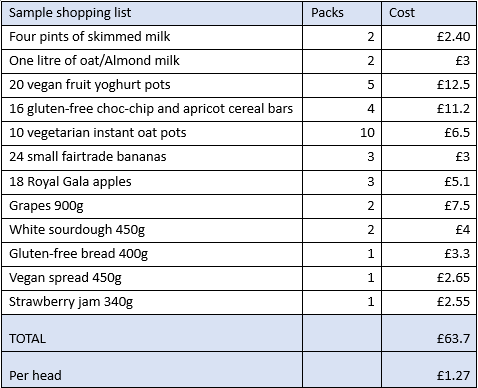
The power of breakfast to boost student attendance
You may also like
Weekly student breakfasts can be a simple yet effective way to strengthen a sense of community on campus, improve the overall student experience and encourage better class attendance. With this in mind, we decided to introduce a regular breakfast event within our chemistry school, creating a welcoming space where students and staff could come together informally at the start of the day.
Our priorities were to ensure the breakfast was free and available for everyone, whatever their level of study. We also wanted to ensure that we catered to as many dietary requirements as possible by making dairy-free and gluten-free options available.
Breakfast runs from 8.30am to 10.30am, allowing students time to eat before 9am lectures or labs. We make a second drop of breakfast available at 9.30am for 10am starters and include “grab and go” options such as cereal bars.
One of our student reps, Jessica, looked into how the students’ association ran their breakfast in terms of cost per head and how many people they catered for. She came back with all the details:
“They are supplying for 100 people, paying £1.10 per head, and £1.30 including staffing. They supply bread, jam, butter, yoghurt, fruit and porridge pouches/pots mainly.”
With that information in mind, we decided we would cater for 50 people out of 650 taught and 200 research students to begin with, and copy the students’ association’s menu and price estimate, which worked out at about £60 per week. Together, we agreed on a well-balanced selection of breakfast items to trial.
Below is a sample shopping list that we started with (we bought tea and coffee in bulk instead of during weekly shops):

We’ve continuously gathered students’ feedback by informally chatting to them at breakfast, making a short survey available via QR code and seeing what runs out the fastest! We print out and display students’ feedback to show what’s been acted upon.
Some of the early feedback included requests for more varied bread toppings, particularly savoury options. When we diversified our breakfast items in response to this, we ensured the breakfast was as accessible as possible by catering to different dietary requirements and religious beliefs. For example, we offered protein-rich alternatives to items such as ham for our Muslim, Jewish and vegetarian students. Our menu has also evolved to include more pastries, juice and herbal teas.
Students pointed out that popular items, such as pastries and yoghurts, ran out quickly. Over time, we increased our offering to cater to more students and rebalanced the shopping list in response to students’ preferences.
It also pays to keep your finger on the pulse. We did a special edition of the breakfast to celebrate Pancake Day.
Spotlight guide: How to motivate students and staff in higher education
Tackling declining attendance with the ‘show up’ mindset
Seven strategies to fuel students’ motivation
To alleviate staff workload, we agreed to have students volunteer to help tidy up. We reached out to the elected student reps in the first instance who were keen to support the continuity of the breakfasts. We didn’t offer any additional incentive to get involved other than sharing that we would need help to keep the breakfasts going. Getting the reps on board allowed us to share our appeal for student volunteers through the social media groups the reps ran. Jessica, our wonderful undergraduate rep, made a rota for which she helped recruit volunteers. We’ve found that having staff set up and students tidy up the breakfasts works really well, and helps it all feel like a co-owned activity.
We decided to keep running the breakfast during the exam period and over the summer. Many services and facilities close between June and August when our undergraduates are away from their studies, but we felt it was important to keep initiatives like this available to ensure our postgraduate students feel seen and valued.
Would we recommend that schools or departments do this for their students? Yes, absolutely! Once you’ve got your regular order set up, it’s pretty easy to run. The feedback has been great, too, with the following benefits (among others) highlighted: a chance to catch up with friends, a great energy boost and extra motivation for their 9am lectures.
Some final top tips from us if you want to organise this at your university:
- If you order from a supermarket, look out for items on special offer (eg, Nectar or Tesco Clubcard prices) to get more bang for your buck without sacrificing quality.
- Buy a delivery pass from your local grocery store; it will save you money and give you more flexibility to arrange deliveries
- Buy long-life items such as teas and coffees in bulk rather than on a weekly basis. Find out from your institution’s administration, procurement or business support teams which approved suppliers at your institution might be suitable
- Look around other schools or departments in your institution for inspiration, as someone might already be doing something similar that you can adapt and learn from.
Jean O’Donoghue is the head of student experience; Jessica Thackeray is an undergraduate student; Adrian Penny is a student adviser and support administrator, all at the University of Edinburgh.
If you would like advice and insight from academics and university staff delivered direct to your inbox each week, sign up for the Campus newsletter.




